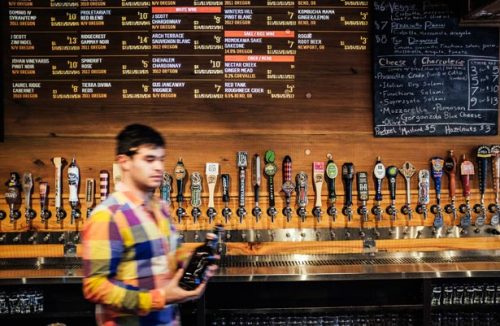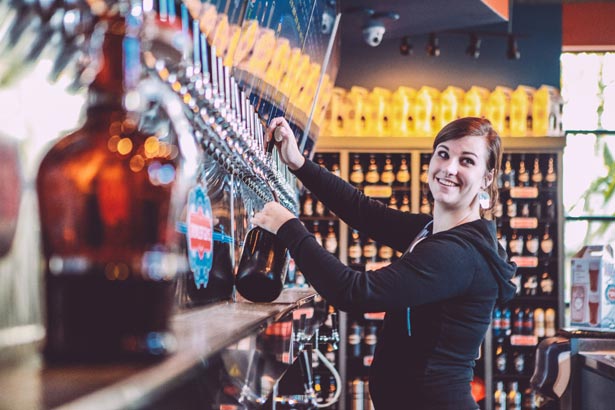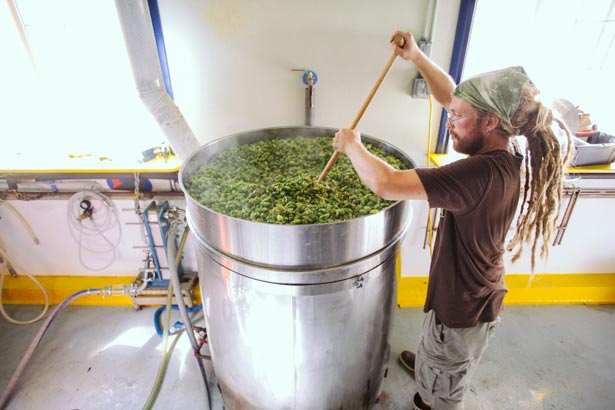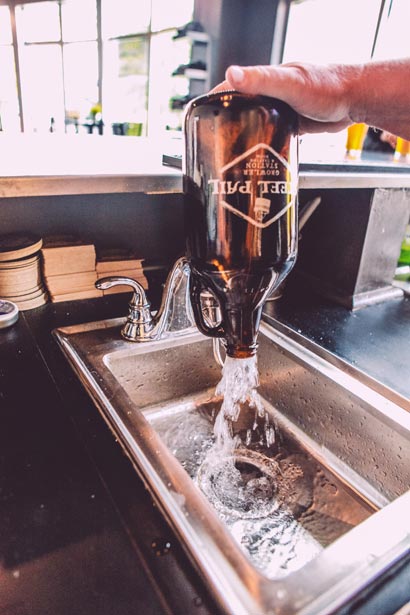
“Soldiers in the American Revolution drew a quart of beer each in their daily rations. When the supply ran short George Washington begged the Board of War in 1777 to rush the growler for more. Washington himself drank beer,” Hal Boyle writes in the 1949 Tuscaloosa News story “Of History And Beer.”
Whether the veracity of Washington’s imbibing habits holds true, there is no doubt that growlers have long been a popular transportable container for beer and wine. Their popularity waned with the rise of the six-pack and mass production in the 20th century, but now a new golden wave of growler-dom is washing over Eugene. Oregon law has allowed breweries and taphouses to fill growlers with beer in the past, but as of last spring the floodgates opened wider when Gov. Kitzhaber signed the “Growler Bill” (aka House Bill 2443), allowing wineries, cider houses, local groceries and other licensed retailers to sell wine and hard cider in growlers to consumers.
This boom has ushered in a new era for libations: the era of the reusable container. In the past six months, four growler fill stations have bubbled up — The Tap and Growler, Growler Guys, Growler Nation, The Steel Pail — and another, Growler University, is slated to open mid-December. Add that to the explosion of breweries in the area, and other licensed retailers that fill growlers, like early adopters 16 Tons as well as grocers, gas stations and teahouses, and it’s safe to say that Eugene is undergoing a growler rush. Even Vanilla Jill’s Frozen Yogurt has gotten into the growler game with six Kore Kombucha (fermented tea) brews on tap. These new laws and options can leave the uninitiated thirsty consumer confused and overwhelmed; EW gives you the 101 on local growler culture, from fill stations to the vessel to the libations’ source.
Just Tap It In
Sharing with the community is, in part, why growler stations have such footing in craft brew meccas like Bend and are gaining popularity in Eugene. “We’re selling things that are not available in stores,” says Patric Campbell, co-owner of The Tap and Growler on 5th and Pearl. Walk into any of the growler stations or growler tap houses and tasting rooms in town — mostly rustic affairs with lots of wood, stone and corrugated tin — and you will be confronted with at least 25 taps of local, regional and international craft beer; most have a smattering of wine and kombucha, and The Tap and Growler also sells craft sodas from Agrarian Ales and Pacori cold press coffee. Places like The Tap and Growler, which Campbell distinguishes as a growler taphouse and tasting room — not just a fill station — also offer flexibility.
“You can order a ‘your choice’ flight,” he says, which could include three beers and three wines, for example, or whatever combinations from the 70-plus taps that tickle your fancy.

The price point of fills is also part of the appeal of growler stations. The cost varies depending on size of vessel and type of beverage, but wine and kombucha are typically cheaper when bought on tap, while beer varies. Many beer consumers complain that a six-pack of beer is cheaper than a 64-ounce growler; however, the beers available on tap are fresher, have undergone less degradation from the distribution process and are often special or seasonal brews that cannot be bought in the store.
“From the consumer point of view, I think it is popular because it is new and because in many cases the prices are pretty cheap. They like selection and the take-home factor,” says Jamie Floyd, co-owner and founding brewer of Ninkasi. “Many people think draft beer tastes better than bottled beer. This logic has transferred over to growler fills — the idea that you are bringing draft beer home without having to have a home draft system.”
The Steel Pail
The original growler in the U.S. was a galvanized steel pail with a lid, hence the name of north Eugene’s The Steel Pail. In fact, pop into The Steel Pail or The Tap and Growler and you can see turn-of-the-20th-century photographs of industrious men and eager lads “rushing the growler” over lunch — or in today’s parlance, “going on a beer run.”
The pail is quaint in comparison to what is now available. The typical modern growler is a 64-ounce (equal to about four pints) brown glass container, but since the craft beer boom, local consumers can find growlers of all shapes, sizes and materials, from a double-walled, vacuum-sealed stainless steel 40-ounce growler (Falling Sky Brewing) to a 64-ounce glass swing-top (The Tap and Growler) to the 2.5-gallon pressurized Kore Kombucha “Growler Party Pig” (available at SeQuential Biofuels). Bilton-Smith, of Growler University, says his station will be the first in town to offer plastic and biodegradable paper growlers, as well as growler bikes with growler cages to tow your brew around town. If you want a really low commitment, grab a Mason jar with a lid. According to Oregon’s relatively lenient growler laws, pretty much any container can be a growler as long as it has a secure cover. In September, Esquire even noted that “laissez-faire Oregon has such lax growler rules, some gas stations also have beer-filling stations and rumors abound that one can show up to some breweries with an empty soda bottle or a Mason jar and get a fill on that.”

‘Think of beer as a loaf of bread – it has the same problems’ — Tobias Schock, Agrarian Ales. Photo by Trask Bedortha.
Prices for containers range from as little as $3 to several hundred dollars. For those starting out, owner of Growler Nation John Stanford advises: “Gauge what you are realistically going to consume” and “start small.” This is key in growler use whether it’s for beer, wine, kombucha or soda — a common rookie mistake is treating a growler as storage. Growlers should not be used to store beer and they must be refrigerated. Growler professionals, like Stanford, will tell you that after breaking the seal on a refrigerated growler, what’s inside will stay good for a couple of days, max; an unopened growler will stay fresh for about two to three weeks.
“Think of beer as a loaf of bread,” says Tobias Schock, co-owner and brewer for Agrarian Ales. “It suffers from the same problems.” Those problems are, essentially, staleness and spoiling, caused by oxidation and loss of carbonation, both of which degrade the integrity of wine and beer.
“Like beer, oxygen, heat and light are all enemies of wine,” says Jonathan Oberlander of J. Scott Cellars. “Oxidation is a biggie. As you open it, the clock starts ticking. Consume the wine four or five days after you open it.”
There are some new beer-centric inventions on the market that are trying to solve this problem, like the Growler Saver, which forces air out and CO2 into the growler, re-pressurizing the beer. Bilton-Smith hints at a gadget that will keep beer draft fresh: “We’ve got a trade secret we will be releasing when we open the store. We’ll be the first to be doing it in Eugene, maybe in any growler station.”
Kombucha consumers, however, are in luck. While Kore Kombucha owner Curtis Shimmin advises one to follow the same rules as wine or beer for the best growler experience, he notes there is a trick of the trade for the fizzy fermented tea. “Put out the beverage for 24 hours at room temperature” without the cap if it has gone flat, Shimmin says. This wakens the bacteria in the kombucha and will re-carbonate it. Then recap and put the growler back in the fridge.
Campbell also advises that you know where you’re going with a growler. A 32-ounce (two pints) glass growler is perfect for a night at home, he says, whereas the more durable stainless steel growler with double walls can keep your beverage cold and fresh on a camping trip. A 64-ounce ceramic growler works great for when you want to protect your sweet nectar from light.

From the Source
Currently, every brewery in the Eugene-Springfield area, except for Ninkasi, fills growlers on site. (Ninkasi’s tasting room currently sells growlers but is still in the process of obtaining a license to fill them.) In addition to brewskies, many local wine sellers like J. Scott Cellars, Sundance Wine Cellars and King Estate Winery fill growlers, as do kombucha retailers such as Kore Kombucha. The resounding answer for utilizing the reusable container is sustainability.
“It’s environmentally friendly — it cuts out packaging,” says Shimmin, who points out that the smaller bottles sold in grocery stores are from China. Oberlander of J. Scott Cellars agrees. “It’s a smaller carbon footprint.”
But the reasons for adding growlers to the repertoire are not purely altruistic. Shimmin says growlers save on the bottom line. “It’s quite a job to get a label designed and get it on the bottle,” he says. “It’s a tremendous expense.” Saving money on packaging and marketing also frees up brewers and vintners to experiment with little risk instead of being locked into a branded line of beverages. This is ideal for a highly seasonal brewery like the Coburg-based Agrarian Ales, which has an ever-rotating tap list of beers, with few repeats. Agrarian brews, like those of Claim 52 Brewing, Viking Braggot (a braggot is a honey- and herb-infused ale) and Falling Sky Brewing, cannot be found in stores — they can be found on tap, either on site, in local bars or now, at growler fill stations.

The growler, Schock points out, is the only way for a consumer to experience fresh beer at home (unless the consumer is a home brewer). A shorter distribution distance between production and consumption makes beer taste better; every step in the distribution process puts the product at risk to temperature swings, light exposure and instability, which can lead to major degradation in taste. Just imagine what that domestic six-pack went through before you picked it up from the convenience store. “Everyone has been drinking this warm shitty beer that’s been degrading on the shelf,” Schock says, joking that it’s the great bottled beer conspiracy.
Ninkasi’s Jamie Floyd sees additional benefits: “Two great parts of growlers come down to choice and also sharing. For example, if you were to visit our tasting room and we have something you really like on tap that we do not bottle, then you can not only bring it home but share it with others.”